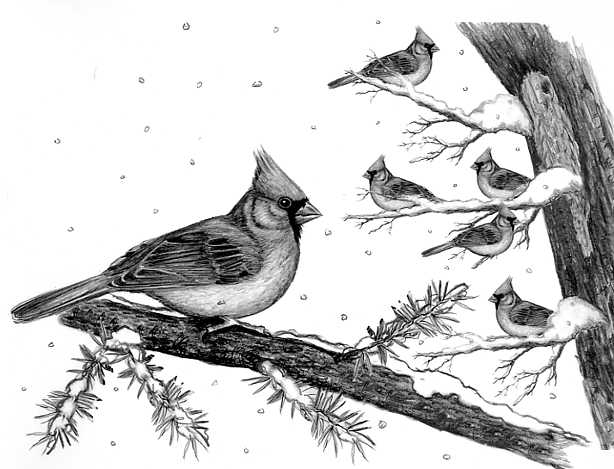
Dear Bird Folks,
This morning my four year old daughter called to me saying that there were a million cardinals in our backyard. I ran to look and there definitely were lots of cardinals. I’d bet there were twenty or more of those colorful birds in one tree, making for a spectacular sight against the snow. Why were there so many? I always thought that cardinals stayed in pairs year round.
-Amy, N. Eastham, MA
Now Amy,
I don’t want to tell you how to raise your daughter, but I don’t think you should let her get away with saying there were a “million” cardinals when there were only twenty. When I was her age my father would have washed my mouth out with soap if I stretched the truth like that. He said that he did it because he wanted me to learn to be honest. At least that’s why he said he was doing it, but I have the feeling that it was because he was too cheap to buy us toothpaste. Of course you know I’m kidding. I think it’s great that your daughter is excited about seeing cardinals. My kids wouldn’t notice a flock of cardinals even if they were flying around inside our house, unless the birds got in the way of the TV. Then there’d be trouble.
If this was summertime, Amy, then your story would be unusual. That is when cardinals are in pairs or family groups. Seeing a flock of cardinals in the winter is a nice spectacle, but it’s not unique. After the breeding season some cardinals remain on their summer territory all winter long, while some join a flock of other cardinals and travel off to some new location in search of food. For many birds a flock can be a tight knit club, with its members basically staying together day in and day out. This is not the case with cardinals. A cardinal flock is more like social circles at a party. Members are constantly changing, depending on which group has the best food or the best gossip. Cardinals may hang out with one flock (of other cardinals) one day, get bored with them, and hookup with a more interesting flock a day or two later.
Factors that determine flock size are the availably food, time of day and weather. Cardinals seem to feed together more in the morning and disperse as the day wears on. Also, the nastier the weather, the larger the flock can be. It’s not clear why some cardinals travel in flocks while others stay home. A flock certainly has a better chance of finding food and has more eyes to watch for danger. But on the other hand, a large flock will devour a food source more quickly and will also get the attention of a predator that might not notice a single bird. No one knows for sure why not all cardinals join flocks, but many scientists believe they base this decision on their horoscope. Makes sense. By late winter things start to change. The birds that have remained on their breeding territory simply start singing, while the flocking birds separate to form their own territories. Cardinals are one of the few songbirds in which both the male and female sing in an effort the announce their territory. In most other birds, it is the male that does all the work. For example, the sweet, clear “fee-bee” song of our pal the chickadee is sung by the male only. Not so with Mr. and Mrs. Cardinal. They both sing out. They also both defend the territory. If strange male bird wanders onto their turf, the resident male gives chase. However, if some other female intrudes, it is the old lady’s job to kick her out.
It’s hard to find a feeder bird that people seem to enjoy seeing more than a cardinal. One of the elements that many people find appealing about them is the notion that “they mate for life.” Well, I hate to burst anyone’s bubble (actually, it doesn’t me bother at all), but there is plenty of divorcing going on in the cardinal world. Just as with humans, new young hotties in the neighborhood can cause problems with cardinal couple as well. The other thing people enjoy about cardinals is that the male will often take a beak-full of food and pass it to the beak of the female. Many people think that is a sweet thing to do, but I’m thinking, ish, germs.
You are lucky to have a “million” cardinals visiting your yard Amy. You are also lucky to have a four year old daughter who appreciates seeing birds. I should offer her a job, even if she can’t tell the difference between twenty and a million. I just won’t let her work the register for another year or so.